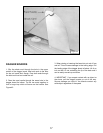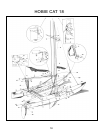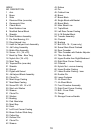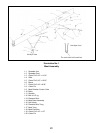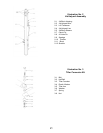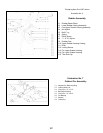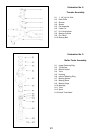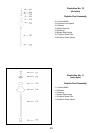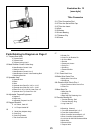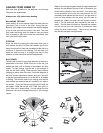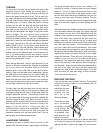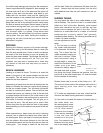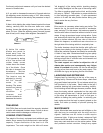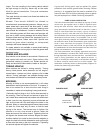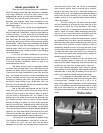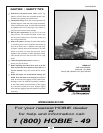
About your Hobie 18’
There are ways of going faster on a catamaran,
while still staying within the eight foot beam, trailerable
size range. Basically, you put a taller mast on, use
daggerboards, and go to a half round hull shape.
The Hobie 18 is the end result of our efforts - mine, Phil
Edwards' (my longtime friend and co-designer of the
18), and those of all the guys on our research and
development team.
First thing, on the 18 you've got daggerboards .
. . the price you pay having symmetrical hulls. And while
they do keep you a little busier - having to raise them up
or down at times - I have found that our boards, with
their raked back leading edge, and the fact that they fit
their trunks well, are really quite easy to use. One quick
tug and they spring up or down, or lock part way, almost
automatically. Under heavy kelp conditions the boards
can be pulled up part way, leaving a very raked back
leading edge which will help dispense of kelp and
sometimes even knock it down and keep it from hanging
up on the rudders.
I find the 18 rudder assembly and locking
mechanism to be much easier to use than the 16's,
which is darn good. Locking the rudders down on the 18
is a more "natural" movement, which in itself is an
improvement over the 16.
The Hobie 18 has a built in mainsheet traveler
car which can be used either as a roller bearing type
traveler or a slider, as we furnish both rollers and slugs.
I have found the best combination is one roller and one
slug. This allows the traveler to move reasonably free
but still provides enough friction so that when you're
pumping or sheeting your main, the traveler car does
not want to keep coming at you all the time. Also, the
fact that it is built internally into the rear crossbar makes
for a clean and neat installation.
One of the really neat features on the 18 is the
roller furling jib. When you're sitting out there luffing,
waiting to start a race or just taking it easy, or even if
you just want to single-hand sail, all it takes is one
simple pull of the string and in about two seconds your
jib is neatly put away. And, of course, it is the ultimate
detuner for heavy air when you want to get some sail
area off the boat fast. Whereas most roller furling jibs
are attached permanently to the forestay, on the Hobie
18 we put a zipper luff with an internal halyard inside the
zipper so you may take the jib off the boat at any time.
That same halyard also serves as your luff tension,
which is another reasonably critical tuning device.
The Hobie 18 is an extremely "tuneable" boat.
You've got all the adjustments - fore and aft, in and out -
luff tension on your jib, and, with the diamond
spreaders on the mast, you are also able to control your
mast bend both ways. Also, the 18 has a controllable
mast rotation device and an internal roller outhaul.
Being as this boat does have a few more strings and
lines on it than a 16, we designed and specially tooled a
boom that carries internally your outhaul and mast
rotation control, to try to keep the lines tucked inside as
neatly as possible.
All of the fittings on the boom are moveable;
with the loosening of a screw you may slide any of the
leads fore or aft as you find convenient. This really
made it simple on us designwise because we didn't
have to figure out exactly where everything should go,
and you, in turn, aren't stuck with our decision and can
move them around until they are comfortable to you.
Being able to control the mast rotation, tension
the diamond wires, and even rake the spreader on the
diamond wires (this may be moved fore and aft to pump
the mast either forward or back slightly) leaves a
tremendous amount of room for tuning the sails on the
18 and getting the maximum performance out of them.
To keep the mast clean and allow for an efficient air
flow, we ran an internal main halyard (the jib halyard is
already internal inside of the jib luff).
Another set of features on the 18 which I like
are the inspection plates in each hull. You can look in
there and see what's happening, and the holes are big
enough so you can stuff things away in the hull. . .
lunch, beer, jackets, whatever. Also, there is a good-
sized pocket on the trampoline that halyard ropes and
assorted odds 'n ends may be stuffed into so you don't
have a lot of loose line laying around on your boat.
It is important to remember that the "fastest"
boat isn't necessarily the "best" boat for everyone. What
is the best boat - whether it be an 18, a 16, a 14, or
some other type of boat altogether, is the one that best
suits an individual's particular wants and needs. A boat
that is the most useful to you personally, one that you
will get the most enjoyment out of, is the best boat in the
world!
Hobie Alter
31



